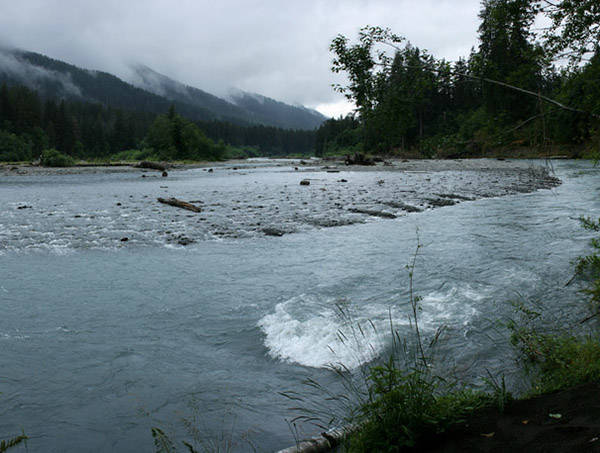The Washington Salmon Recovery Funding Board announced on Monday the award of nearly $18 million in grants for projects to restore salmon habitat in an effort to bring the iconic fish back from the brink of extinction. An estimated 75 percent of the funded projects will benefit Chinook salmon, which make up a large part of the southern resident orca whale diet.
“This funding helps protect one of our most beloved legacies,” said Gov. Jay Inslee. “Together we’re taking a step forward for salmon, and in turn dwindling southern resident orca whales, while also looking back to ensure we’re preserving historic tribal cultural traditions and upholding promises made more than a century ago.”
Since the creation of the Salmon Recovery Funding Board in 1999, the board has awarded more than $700 million in state and federal funds to more than 2,650 projects across the state. With matching funds provided by grant recipients, the amount invested in board-funded salmon recovery projects is $987 million.
The Salmon Recovery Funding Board awarded grants to organizations for 95 projects in 30 of the state’s 39 counties. Grant recipients will use this funding to remove barriers that prevent salmon from migrating, increase the types and amount of salmon habitat, conserve pristine areas and replant riverbanks to increase places for salmon to spawn, feed, rest, hide from predators and transition from freshwater to saltwater and back again.
The Salmon Recovery Funding Board funded projects in the counties below:
Asotin County$77,535
Chelan County $1,006,716
Clallam County$762,420
Clark County$689,142
Columbia County$857,484
Cowlitz County$988,691
Garfield County$61,450
Grays Harbor County$437,633
Island County$217,645
Jefferson County$475,220
King County$645,895
Kitsap County $531,047
Kittitas County $1,172,830
Klickitat County $445,035
Lewis County$964,520
Mason County$783,956
Okanogan County$849,084
Pacific County $899,521
Pend Oreille County $342,000
Pierce County$1,050,095
San Juan County$277,742
Skagit County$1,326,168
Skamania County $249,916
Snohomish County$1,052,178
Thurston County $308,390
Wahkiakum County$424,045
Walla Walla County$480,936
Whatcom County$437,611
Whitman County $41,795
Yakima County$125,715
Recent studies show that every $1 million spent on watershed restoration results in between 15.7 and 23.8 jobs and up to $2.5 million in total economic activity. The funds awarded this week are estimated to provide up to 470 jobs during the next 4 years and up to nearly $50 million in economic activity. These new grants will put contractors, consultants and field crews to work designing and building projects and restoring rivers and shorelines. It is estimated that about 80 percent of these funds stay in the county where the project is located.
The board also approved ranked lists of Puget Sound Acquisition and Restoration program projects to submit to the Legislature for funding consideration. The project requests totaled nearly $21 million with another $46 million requested for larger projects.
The Puget Sound Acquisition and Restoration program is a state capital bond-funded program focused on Puget Sound and Hood Canal, jointly administered by the Recreation and Conservation Office and the Puget Sound Partnership.
“Salmon are the heart of nature’s system in Puget Sound,” said Sheida Sahandy, executive director of the Puget Sound Partnership. The Partnership’s Leadership Council is the regional salmon recovery organization for most of Puget Sound’s salmon species. “They feed our orca, and they also nourish people. They provide cultural, economic and physical well-being to the entire system. These projects help fulfill our responsibility to sustain the salmon that sustain us.”
Projects are selected by lead entities, which are watershed-based groups that include tribes, local governments, nonprofit organizations and citizens. Lead entities recruit projects and sponsors, vet projects based on federally approved regional salmon recovery plans and prioritize which projects to submit to the Salmon Recovery Funding Board for funding. Regional salmon recovery organizations and the board review each project for cost-effectiveness and to ensure they will benefit salmon.
“With steady checks and balances throughout the process, this bottom-up approach is the backbone of our efforts to ensure a thriving future not only for salmon, but for orcas, other wildlife and ultimately — us,” said Kaleen Cottingham, director of the Washington State Recreation and Conservation Office, which administers the grants. “It consistently produces projects with widespread support that are rooted in our local communities.”
Washington state salmon populations have been declining for generations. As Washington grew and built its cities and towns, it destroyed many of the places salmon need to live. In 1991, the federal government declared the first salmon as endangered.
By the end of that decade, salmon populations had dwindled so much that salmon, steelhead and bull trout were listed as threatened or endangered in three-quarters of the state.
Those listings set off the formation of the Salmon Recovery Funding Board to oversee state and federally funded investments in salmon recovery.
Grant funding comes from the Legislature-authorized sale of state bonds and from the federal Pacific Coastal Salmon Recovery Fund, which National Oceanic and Atmospheric Administration’s National Marine Fisheries Service administers.
Information about the Salmon Recovery Funding Board and the Recreation and Conservation Office is available online at www.rco.wa.gov.



